 History
History  History
History  Movies and TV
Movies and TV 10 Directors Who Made the Same Film Twice
 Gaming
Gaming 10 Strangest Video Game Tie-Ins for Famous Musicians
 Creepy
Creepy 10 Creepy Rituals Hidden in Ancient Burials
 The Arts
The Arts The 10 Most Pioneering Yet Polarizing Premieres in Classical Music
 Travel
Travel 10 Countries Where You Can Live in Luxury for Cheap
 Crime
Crime 10 Cases of Mothers Slain by Their Own Children on Mother’s Day
 Humans
Humans 10 Extremely Simple Concepts That Completely Changed the World
 History
History 10 Times People Swore the Apocalypse Was Just Around the Corner
 Weird Stuff
Weird Stuff 10 Strangest Objects People Have “Fallen” On
 History
History The 10 Weirdest Wars in History
 Movies and TV
Movies and TV 10 Directors Who Made the Same Film Twice
 Gaming
Gaming 10 Strangest Video Game Tie-Ins for Famous Musicians
Who's Behind Listverse?

Jamie Frater
Head Editor
Jamie founded Listverse due to an insatiable desire to share fascinating, obscure, and bizarre facts. He has been a guest speaker on numerous national radio and television stations and is a five time published author.
More About Us Creepy
Creepy 10 Creepy Rituals Hidden in Ancient Burials
 The Arts
The Arts The 10 Most Pioneering Yet Polarizing Premieres in Classical Music
 Travel
Travel 10 Countries Where You Can Live in Luxury for Cheap
 Crime
Crime 10 Cases of Mothers Slain by Their Own Children on Mother’s Day
 Humans
Humans 10 Extremely Simple Concepts That Completely Changed the World
 History
History 10 Times People Swore the Apocalypse Was Just Around the Corner
 Weird Stuff
Weird Stuff 10 Strangest Objects People Have “Fallen” On
Top 10 Olympic Nightmares And Mishaps
The international sporting events of the Olympic Games are a testament to the unwavering dedication of leading athletes around the world. Participants spend their entire lives training and competing, honing their skills and rising to the tops of their games in order to be able to call themselves Olympians. And yet, only some will get to proudly stand before the eyes of the world, medals hanging from their necks.
In spite of the glory of the Olympics, human nature takes a prominent toll anywhere. On occasion, this has engendered life-altering mishaps never to be forgotten. As opposed to delving into notorious calamities that have befallen competitors, the following ten entries examine lesser-known nightmares surrounding the Olympics.
10 The Silence Of The Doves

At the 1896 Olympics in Athens, birds were released as a sign of peace and freedom. The act officially became a part of the opening ceremonies beginning in 1920 at the Antwerp Games. While it’s theorized that the tradition dates back centuries, historians claim that homing birds were first released during the ancient Olympics in order to notify families and villages of a returning hometown athlete’s victory.
Unfortunately, the symbolic custom would be anything but festive during Seoul’s opening ceremony in 1988, when a few feathers became ruffled. As three athletes rode a rising platform skyward to light the enormous torch, numerous doves made the unfortunate error in judgment of resting atop the cauldron prior to its ignition. As the three torches lit the flame, a Korean barbecue ensued, turning white feathers into ash for the world to see. It immediately became apparent that it was vital for the Olympic committee to alter future ceremonial procedures in order to avoid another embarrassing public spectacle.
In 1992, no birds were burned. The doves were released well before the lighting of Barcelona’s cauldron, bringing tranquility to animal enthusiasts everywhere.[1]
9 Unjust Reputation
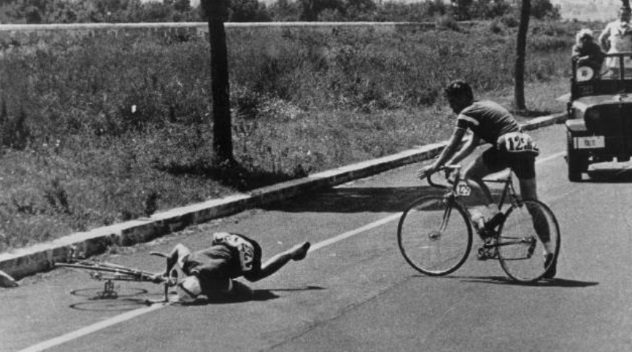
Prior to the 1968 Summer Olympics in Mexico City, testing for drug use among Olympic athletes wasn’t carried out. The deficiency of such regulations should have been evident following the 1952 Oslo Winter Games, when several speed skaters overdosed on amphetamines and required medical intervention.
However, it took the untimely death of Danish cyclist Knud Jensen at the Summer Olympics in Rome in 1960 for anti-doping campaigns to gain prominence. Jensen, whose notoriety is rooted in becoming the first Olympic athlete to die of a drug overdose during competition, became the exemplar of an admirable objective fueled by immoral measures. His demise was a picturesque epitome for crusaders destined to increase the regulation of doping at the expense of Jensen’s reputation.
In reality, the cyclist’s autopsy stated that although the he had amphetamines in his system, they were unlikely to have contributed to his death. Nonetheless, Jensen’s passing—medically attributed to heatstroke—was exploited as propaganda. To date, the myth surrounding the first athlete to overdose persists amid tons of evidence proving otherwise.[2]
8 Honor

At the 1964 Summer Olympics, Kokichi Tsuburaya, a first lieutenant in the Japan Ground Self-Defense Force, had the distinct honor of representing his nation on his home turf in Tokyo. Such a privilege, however, would prove to be nothing more than an immense disappointment for the lead marathoner, who was overtaken in the final 100 meters, finishing third. In spite of taking home a bronze medal, Tsuburaya was mortified, believing he had brought shame upon himself, his family, and his fellow countrymen.
The arduous burden rooted in pride was a driving factor for Tsuburaya to succeed in future marathons. He stated, “I committed an inexcusable blunder in front of the Japanese people. I have to make amends by running and hoisting the Hinomaru in the next Olympics, in Mexico.” Sadly, Tsuburaya’s aspirations would never come to fruition after an ongoing lower back pain problem began to take effect shortly after the Tokyo games.[3]
As the pain became increasingly debilitating, Tsuburaya’s sight on the gold medal began to diminish. The mere thought of another humiliating defeat was more than the first lieutenant could bear, and on January 9, 1968, he committed suicide in his dormitory room by slashing his right wrist with a razor blade. Tsuburaya’s suicide note cited his inability to run as the reason for his actions.
7 Blazing Torch
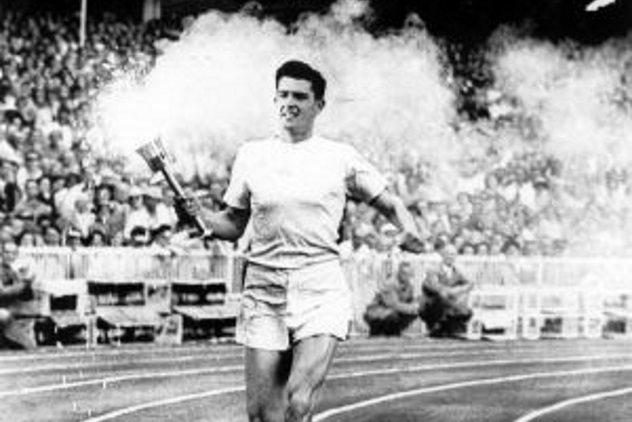
During the opening ceremony at the 1956 Olympics in Melbourne, junior mile champion Ron Clarke was making the lap of honor around the main stadium’s arena, never realizing that the flesh of his right arm was being burned. As he circled, the tumultuous applause of the stadium made Clarke oblivious to the fiery particles spilling from the torch he carried. Only after being presented with a medallion by an official did Clarke realize he had not only left a trail of fire on the track behind him but that the embers had burned through his shirt and scorched parts of his arm.
Clarke’s amusing predicament is child’s play compared to the sizzling mishap that occurred at the 1968 Summer Olympics. During exchanges of the torches’ flame, several runners were burned by minor explosions when the torches would touch. Fortunately for the seared runners, the solid fuel, a mixture of nitrates, sulfur, alkaline metal carbonates, resins, and silicons, was nontoxic. It was, however, volatile during rapid contact between a lit torch and an unlit one.[4]
6 Hot Dogs

Due to its special ingredient, the popular dish bosingtang has caused quite the ruckus among foreigners visiting Pyeongchang for the 2018 Winter Olympics. Throughout the South Korean city, countless restaurants continue to serve the traditional stew made of dog meat despite government pressure and financial incentives aimed at curbing sales in the hopes of appeasing offended tourists.[5] Such measures were taken before the 1988 Seoul Olympics, during which the sale of the meat became restricted in parts of the city. What came about was a surprising backlash fueled by patriotism among some Koreans, who began eating more dogs solely to spite imposing foreign views.
Interestingly enough, Korean traditionalists have long believed that meat from a dog contains mythical properties that increase virility and boost restorative powers. Although the demand is decreasing these days due to a lack of popularity among younger members of Korean society, the off-putting custom remains prevalent in rural regions of the country. In fact, bosingtang is one of many dog meat delicacies available to those craving a domesticated dish, including dog salad, dog ribs, and a dog “hot pot,” just to name a few.
5 1904 Spectacle
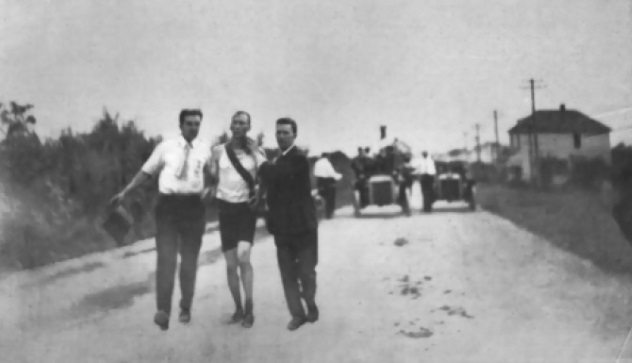
The 1904 Summer Olympics in St. Louis have been epitomized as one of the more bizarre exhibitions in athletic history. Having been overshadowed by the World’s Fair, the games were entwined with the fair’s own roster of sporting events, which included mudslinging and “ethnic” dancing solely for the amusement of Caucasian spectators. Meanwhile, the outcome of the Olympics’ foremost event, the marathon, was a cluster of moronic spectacles beyond epic proportion. Only a handful of runners were recognized marathoners, and the majority of the race was composed of “oddities,” including ten Greek nationals who had never competed in a marathon and two barefoot Tsuana tribesmen from South Africa, who were only in town as part of the Fair.
To make matters worse, the heat and humidity along the course was detrimental for the health of athletes subjected to their coach’s farcical demands, which included the irrational minimization of fluid intake. Several athletes suffered bouts of vomiting and debilitating stomach cramps, one was chased miles off course by wild dogs, and others stole food from humorless spectators. American gold medalist Thomas Hicks was fed strychnine and egg whites by his compassionate coach, who watered down the concoction with brandy in what has become the first recorded instance of drug use in the modern Olympics.[6]
4 Deadly Practice

The Olympic Games are not for the faint of heart, with accidents and injuries occurring quite often during competition. Though it’s rare for an athlete to die, the names of those killed while training are often forgotten, never having stepped foot on the world’s stage. Such was the case for 22-year-old Nigerian runner Hyginus Anugo, who was struck and killed by a car while training in Southwestern Sydney in 2000.
During the 1964 Winter Olympics in Innsbruck, Austria, British luger Kazimierz Kay-Skrzypecki was killed in a wreck during practice, as was Australian skier Ross Milne, who collided with a tree after flying off the course of the slope.[7] From crashing into steel poles at the 2010 Winter Games in Vancouver to sunstroke deaths at the 1912 Summer Olympics in Stockholm, perhaps the most reckless death of all occurred at the 1992 Winter Olympics in Albertville, France. Swiss speed skier Nicholas Bochatay leaped over a small hill during warm-ups and crashed into an oncoming tractor-like vehicle used to groom the trails. To add insult to injury, Bochatay’s death came within minutes of competition.
3 Neighbors To The North

Rising tensions between South Korea and their neighbors to the north is nothing new, especially during the Olympic season. From the moment Seoul first won its bid to host the 1988 Summer Games, North Korea was determined to disrupt the esteemed festivities at all cost. The regime’s determination took a diabolical turn on November 29, 1987, when Korean Air Flight 858 from Baghdad to Seoul disappeared above the Andaman Sea with 115 passengers aboard. South Korean president Chun Doo Hwan immediately blamed the North, formally charging the country for the tragedy two months later. To no one’s surprise, the communist government denied the allegations and followed up with copious ineffective attempts to persuade allies—China and the Soviet Union, specifically—to boycott the games.
The world would eventually learn what truly occurred on that fateful flight when Kim Hyon Hui admitted her involvement. The North Korean agent described in immaculate detail how she and her accomplice, Kim Sung Il, planted a timed explosive on the jetliner disguised as a radio. The jubilation of the dynamic duo’s mission of creating “chaos and confusion in South Korea” came to an abrupt end upon their arrest. Both swallowed cyanide capsules after being arrested. While Sung Il succumbed, Hyon Hui survived.[8] She was sentenced to death but was eventually pardoned and lives her life a free woman today.
2 Estadio Nacional Disaster
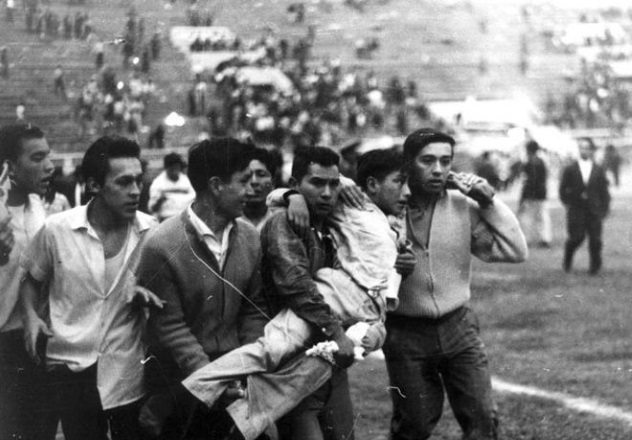
One of the world’s worst stadium disasters occurred in Lima, Peru, on May 24, 1964, when a rambunctious crowd of committed football fans became slightly perturbed at a referee’s erroneous call. While Peru and Argentina were competing in a qualifying round for the Tokyo Olympics, an equalizing goal for Peru was disallowed, infuriating home fans at the Estadio Nacional. Within seconds, a vicious skirmish between police and the crowd ensued.
As tear gas rained down on 53,000 spectators, those who attempted to flee into the streets found themselves barricaded behind closed gates, and they asphyxiated in the tightly packed tunnels. While the official death toll remains at 328, it is not reflective of the number of victims killed outside the stadium by police gunfire. In fact, that number may never be known, given that countless corpses with bullet wounds mysteriously vanished from the mortuaries, and the names of the dead were never recorded.[9]
1 156 Voices
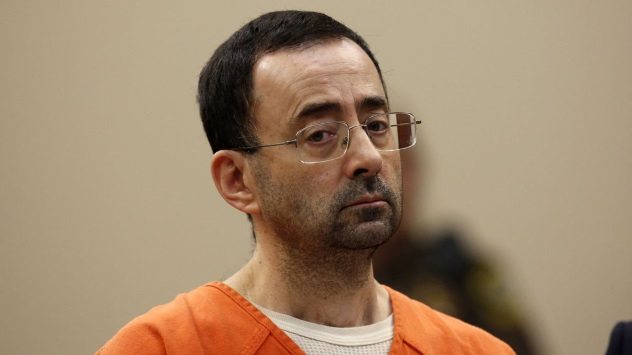
“I’ve just signed your death warrant,” Judge Rosemarie Aquilina said in a Michigan courtroom in January 2018 after sentencing Dr. Larry Nassar to 40 to 175 years in prison.[10] While the disgraced former USA Gymnastics doctor lowered his head in shame, the country questioned how the sexual assault of more than 150 girls and young women continued, or perhaps was overlooked, for two decades. Of the 156 women who took the stand recounting the abuse they endured under the guise of medical treatment, it became nauseatingly apparent that countless victimized voices were ignored over the years by organizations in power, primarily USA Gymnastics, Michigan State University, and the US Olympic Committee.
In spite of pleading guilty to seven counts of criminal sexual conduct, in a letter he had recently written to the court, Nassar accused his victims of lying, blamed the media for his ruined reputation, and claimed that he was manipulated into pleading guilty. The 54-year-old degenerate also wrote, “Hell hath no fury like a woman scorned.”
Adam is just a hubcap trying to hold on in the fast lane.
Read about more weird and wild Olympic events on 10 Crazy Tales From Olympic History and 10 Amusingly Bizarre Tales From The First Modern Olympics.








